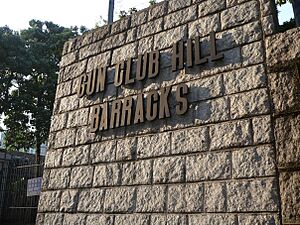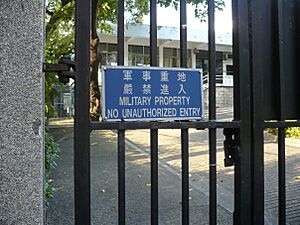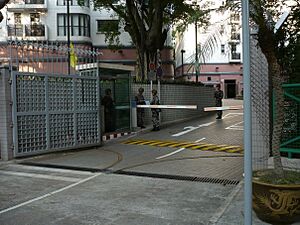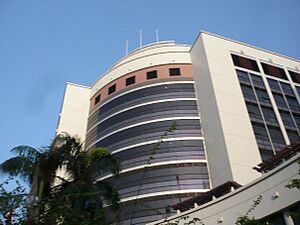Gun Club Hill Barracks facts for kids
Quick facts for kids Gun Club Hill Barracks |
|
|---|---|
| Chinese: 槍會山軍營 | |
| Hong Kong | |

Gun Club Hill Barracks
|
|
|
Location within Hong Kong
|
|
| Coordinates | 22°18′11″N 114°10′37″E / 22.303°N 114.177°E |
| Type | Barracks |
| Site history | |
| Built | circa 1863 |
| Built for | War Office |
| In use | 1863-Present |
| Garrison information | |
| Occupants | People's Liberation Army |
| Gun Club Hill Barracks | |||||||||||||
|---|---|---|---|---|---|---|---|---|---|---|---|---|---|
| Traditional Chinese | 槍會山軍營 槍會山兵房 |
||||||||||||
| Simplified Chinese | 枪会山军营 | ||||||||||||
|
|||||||||||||
The Gun Club Hill Barracks are important military buildings in King's Park, or Jordan, Hong Kong. For a long time, they were used by the British Army when Hong Kong was a British colony. The military started using this area soon after 1860, when the British took control of Kowloon. The barracks are surrounded by Austin Road, Jordan Path, Gascoigne Road and Chatham Road South.
Today, the barracks are used by the People's Liberation Army (PLA). They took over the facility on 1 July 1997, when Hong Kong became part of China again. The area now includes a hospital built for the PLA around 1997.
Contents
A Look Back: Early Days of the Barracks
The Gun Club Hill Barracks have a long history in Hong Kong's military story. They were built because soldiers needed a place to live on the Kowloon Peninsula. This happened after the British gained control of the area in 1863, following the Second Opium War. The British needed more military bases to house soldiers and protect both sides of the harbour.
Since the shoreline was used by regular people, areas in King's Park were chosen for military camps. This area used to have gardens, streams, and rice fields. It was also a popular spot for hunting birds. Once the military camps were set up, several shooting ranges were built for training. This is likely how the area got its name, "Gun Club Hill."
The barracks area is about 10 hectares (25 acres) today. However, the original Gun Club Hill Barracks covered a much larger space. The military first set up many tent camps in places where Kowloon Park, Gun Club Hill, and King's Park now stand. These camps were connected to civilian areas by horse trails. Over the years, the area used by the barracks became smaller, focusing on the "Gun Club Hill" part between Jordan and Austin Road.
From Tents to Permanent Buildings (1860-1950)
In the early days (1860-1889), there were no permanent buildings at Gun Club Hill. Soldiers from other barracks, like Murray and Victoria Barracks, would come and stay in tents and temporary shelters. They practiced shooting with rifles and larger weapons. The first soldiers stationed here were the "Gun Lascars," who were Muslim artillery gunners from India.
Some of the groups of soldiers who stayed here during this time include:
- 1863 The Second Battalion 20th Foot arrived in December.
- 1888 The 91st Argylls arrived in December and stayed in temporary shelters during a quarantine period.
- 1892 The Argylls were replaced by the 1st Battalion, The King's Shropshire Light Infantry. They also had to stay in temporary shelters because of a smallpox outbreak on their ship.
- 1899 Several companies of the Royal Welch Fusiliers were stationed here.
Between 1900 and 1950, the roads around the barracks, like Chatham Road and Austin Road, were gradually built. Gascoigne Road was named after Maj. Gen. Sir W.J. Gascoigne, who was a British military commander in Hong Kong from 1898 to 1903.
The first permanent buildings for soldiers were built in 1903-1904. These were soon used by the Asiatic Artillery, which included Sikh and Punjabi Muslim soldiers. By 1905, four companies of soldiers were living in new barrack blocks near the parade ground. These buildings were made of brick, granite, and strong wood. By 1909, more buildings were added, including an Infants School, a cook-house for Sikh and Muslim soldiers, and quarters for officers and sergeants.
In 1910, the first full battalion was organized at Gun Club Barracks, with about 446 soldiers. The Officers' Mess building was improved, and a new entrance wing was added by 1930, which you can still see today.
Important events during this period:
- 1904 Barracks Blocks, Officers' Mess, Guard House, and Soldiers' Canteen were built.
- 1905 Gun Club Barracks housed the Asiatic Artillery.
- 1909 Muslim/Sikh Cook-house and Followers' Hut were built.
- 1910 The 1st Battalion, The King's Own Yorkshire Light Infantry, was stationed here.
- 1914-18 During World War I, armed forces in Hong Kong were ready for action.
- 1942-45 During the Japanese Occupation, equipment was left behind when British forces moved to Hong Kong island.
- 1947 The 25 Field Regiment, Royal Artillery, was stationed at Gun Club.
- 1949 The 58 Medium Regiment, Royal Artillery, was at Gun Club.
After the War (1950-1997)
After the Japanese occupation, many different British regiments were stationed at Gun Club Barracks. Other groups also shared the area, like the United Services Recreation Club.
Here are some of the British military groups who stayed at the barracks:
- 1956-1957 The 15 Medium Regiment Royal Artillery.
- 1965-1967 The First Battalion Queen's Own Buffs.
- 1967 The First Battalion Lancashire Fusiliers.
- 1969 The First Battalion The Royal Welch Fusiliers.
- 1971 The First Battalion The Black Watch.
- 1974 The First Battalion The Royal Hampshire Regiment.
- 1976-1977 The First Battalion The Light Infantry.
It's important to know that the barracks were not just for infantry soldiers. For example, the 34th Light Anti-Aircraft Regiment was stationed at Gun Club from 1961 to 1963.
In 1977, parts of the Alanbrooke Block (British military living quarters) and the Infants’ School were taken down. This made space for new Gurkha living quarters, a temple, a clinic, and a school, which started being built that same year. Other Gurkha units, like the Gurkha Transport Regiment, also moved to Gun Club Barracks.
In 1986, a skeleton believed to be from the Japanese occupation was found during digging work. In the same year, new classrooms were built at Gun Club Primary School. A few years later, in 1989, there were two big floods during Typhoon Brenda. These floods caused a lot of damage to buildings and vehicles.
The 1990s brought more changes. A new military hospital was built facing Jordan Road. Some old buildings were removed to make way for it. Some large banyan trees were moved to other parts of the barracks or to the new Kowloon Walled City Park. In 1995, the barracks were handed over by the British Gurkha regiment to the Hong Kong Government. Finally, in 1997, a new chapter began when Hong Kong was returned to China, and the People's Liberation Army became the new users of these historic facilities.
Gun Club Hill Barracks Today (1997 onwards)
Today, the barracks are used by the People's Liberation Army (PLA). They have been using the barracks since 1997. The area now includes a hospital, housing blocks for soldiers, a primary school, grocery stores, and many other useful facilities.
In 2015, a politician named Albert Chan Wai-yip suggested that the barracks should no longer be used by the military. He thought the land could be used to build more homes for people in Hong Kong.
Gun Club Hill Barracks Military Hospital
Construction on a new hospital at the barracks started in 1994 and was finished in 1997.
The Gun Club Hill Barracks Military Hospital provides medical care for all PLA soldiers stationed in Hong Kong. It is located within the barracks, near Gascoigne Road, Jordan Road, and Jordan Path.
This large hospital has almost 17,000 square meters (183,000 square feet) of space. It includes six buildings: the main hospital, a multi-purpose building, a restaurant, two buildings for staff housing, and a changing room block.
The main Hospital Building has a curved lower part and an L-shaped 11-story tall part. It has medical areas like general surgery wards, rooms for out-patients, and an X-ray lab. The Composite Building is a seven-story rectangular building next to the hospital. It supports the whole complex and holds many of the machines and electrical systems.
Protecting History
Some buildings within the Gun Club Hill Barracks are considered important historical sites. They have been listed as Grade II and Grade III historic buildings, meaning they are protected.
Images for kids















